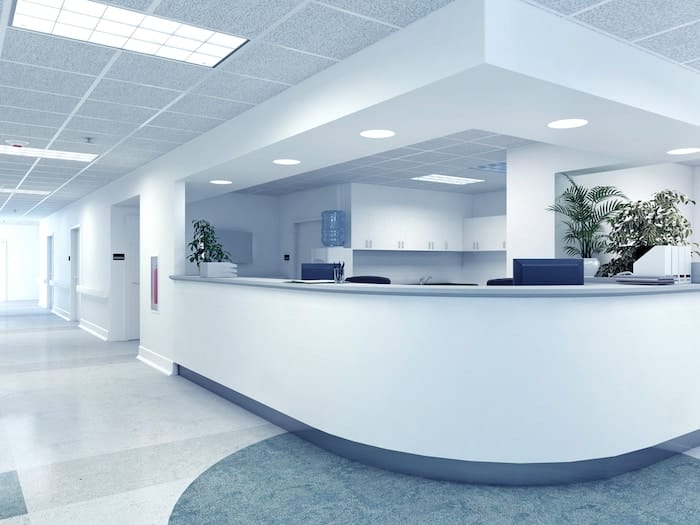Cool Photos from Depositphotos
Audit scores should be about more than just compliance, says Dan Teare, Sector Director at mpro5
The new National Standards for Cleanliness have focused trusts’ attention on complying with the defined criteria of the new crucial 50-point check. However, are they seizing this opportunity to improve the effectiveness of their cleaning processes, or are these new rules just another box to tick?
A fully connected system will allow you to view your data regularly, moving you to a state of continual assurance, instead of compliance at the point of audit. This is central to seeing your audits not as a check on failure, but as a tool to aid constantly developing and building trust in your operations; to do this, you must turn your data into insights.
Valuable insights
The standards specify how healthcare facilities should be cleaned in minute detail, but it’s up to you to understand the underlying reasons for your scores – good or bad. This makes a fully integrated system vital for gleaming a clear understanding from your data.
For example, we all know that old or damaged equipment can harm your score. And we’re not necessarily talking about sensitive medical equipment. It could be something as innocent as the ancient microwave staff use to warm up their lunch. This is just one of the reasons it makes sense to work closely with your trust’s maintenance team. These insights are only possible when you can access and examine all the relevant data to identify cause and effect.
When a hospital audit involves examining every room individually, pinpointing which question is the most common point of failure and making a tiny change will have an immense impact across the hospital as a whole.
Identifying recurring issues gives you the option to adjust your training or even run a dedicated session focused on a specific area – to help automatically improve your score and ensure a better result next time.
Joined-up systems
A digital solution gives you the ability to spot recurring issues across the trust and resolve them efficiently. For example, if your operating theatre walls frequently lose chunks of plaster to hospital beds as they’re wheeled in and out, repairing each defect piecemeal could be time-consuming and costly. You could get them fixed en masse with a digital solution, which allows you to log the location and a photograph of each defect during the audit, removing the need to return and assess the size of the job before obtaining a quote from the contractor.
If streaky floors are a consistent problem, examine the data to discover why. Is this a localized problem? Are mop heads changed often enough? Are cleaners adding too much product to their water? And are they using an ‘S-shape’ motion to clean surfaces and floors?
Don’t shoot the cleaners!
Cleaning failures aren’t automatically the responsibility of the cleaners. Other departments’ actions can affect hygiene standards: cleaning and waste management, for example, are intrinsically linked. The standards acknowledge this, and they emphasize the importance of proper training on procedures and the clear delineation of responsibilities for infection prevention and control.
Another example of this concerns the risk of ‘transference’ – when cleaning solutions become contaminated during use and need to be regularly replaced to prevent the transfer of micro-organisms from one surface to the next – particularly when cleaning heavily soiled areas. Complying with this audit requirement involves not just the act of cleaning but also the management of your supplies and the understanding of your assets. This could well be another team’s responsibility (another reason having a joined-up system is essential).
The best digital solutions help you uncover root causes of audit failure by creating feedback loops and visualizing the data in dashboard reports. One of our clients, an NHS trust, uses mpro5 to manage both its maintenance and cleaning processes. This allows it to seamlessly link any audit failing to a maintenance task, log the remedial action taken with photographic evidence, and close the feedback loop quickly with minimal administrative effort.
About mpro5
mpro5 is a digital transformation solution that improves operational effectiveness, ensures process compliance and drives productivity gains and cost savings for businesses, typically but not uniquely, in facilities management, retail, transportation and healthcare.
An innovative, configurable platform that unifies cloud, mobile and smart technologies to enable the quick implementation of tailored, digital processes, turning complex jobs, workflows and scheduling into simple, effective and continuously compliant processes.
mpro5 is a subsidiary of AIM listed Crimson Tide and has offices in the UK, US and Ireland
The Editorial Team at Healthcare Business Today is made up of skilled healthcare writers and experts, led by our managing editor, Daniel Casciato, who has over 25 years of experience in healthcare writing. Since 1998, we have produced compelling and informative content for numerous publications, establishing ourselves as a trusted resource for health and wellness information. We offer readers access to fresh health, medicine, science, and technology developments and the latest in patient news, emphasizing how these developments affect our lives.









